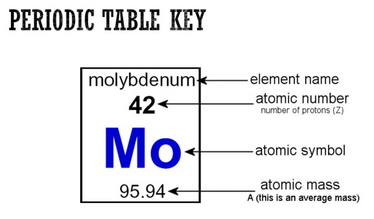By: Molly Friedman
No matter how much experience you have with chemistry, you’ve definitely heard of the periodic table. A staple in every science classroom, the periodic table tells us everything we need to know about all 118 elements. You may have noticed that the elements are grouped in a very specific way, but what information does the periodic table actually give us? Well fasten your atomic seatbelt, because we are about to learn all about the periodic table.

Let’s take a look at my favorite element, molybdenum! This is a zoomed in picture of molybdenum on the periodic table. Front and center, we see the atomic symbol, Mo. Each element has an atomic symbol with one, two or three letters that helps us quickly identify what element we are working with (you probably know some more common atomic symbols like Au for gold or Na and Cl for sodium and chlorine). At the very top, we see the full name of the element. Below, we see the atomic number. Let’s break that down.
There are three super-small particles that come together to form all known atoms: protons, neutrons, and electrons. Protons and neutrons reside in the nucleus of an atom, and electrons occupy the space surrounding the nucleus. Right under the element name, the atomic number gives us the number of protons in the atom. Protons and neutrons are MUCH larger and heavier than electrons. A proton or neutron has nearly 2,000 times the mass of an electron. So we can essentially ignore the mass of electrons in our calculations. The nucleus of a neutral atom has an equal number of protons, neutrons, and electrons. So if molybdenum has 42 protons and 42 electrons, then why is the atomic mass (composed of only protons and neutrons as we said before) 95.94 instead of (42 protons + 42 electrons = ) 84? This is due to something called an isotope.
“What is an isotope?”, you may ask. Well, an isotope is a neutral atom that has the same number of protons (an element is defined by its number of protons, this cannot change) but a different number of neutrons. Isotopes form in a variety of different ways that are beyond the scope of this blog post, but what we do need to know is that many different isotopes can form for a specific element. Some isotopes you might be familiar with are Carbon-12 and Carbon-14, which are used to date different fossils. Carbon-12 and Carbon-14 describe carbon atoms with 12 and 14 neutrons, respectively. If we apply the idea of isotopes to atomic mass (the mass of the protons and neutrons in an atom), we can see that different isotopes will have different atomic masses depending on the number of neutrons in their nuclei. Molybdenum might have 54 neutrons (making for an atomic mass of 42 protons + 54 neutrons = 96 atomic mass units) or 56 neutrons (making for an atomic mass of 42 protons + 56 neutrons = 98 atomic mass units) or some other number of neutrons.
So how do we get a decimal value for atomic mass? The atomic mass of an element that is indicated on the periodic table shows us a weighted average of all of the existing isotopes of an element. A weighted average means that we take into account how much a certain isotope occurs in nature, and we let it contribute to that overall atomic mass accordingly. So if the isotope of molybdenum with 54 neutrons (96 atomic mass units) is more present in nature than the isotope of molybdenum with 56 neutrons (98 atomic mass units), then the overall atomic mass of molybdenum will be closer to 96 than 98, which is what we see as indicated by the atomic mass of 95.94 on the periodic table.
Different periodic tables have different amounts of information based on what the periodic table is being used for, but those four pieces of information discussed (atomic symbol, atomic name, atomic number, and atomic mass) are pretty standard across periodic tables.
Now, you know all about the periodic table and what information it gives us. So next time you walk into your science classroom (which fingers crossed will be soon!) and see the periodic table on the wall, you can amaze your friends with you vast knowledge of the periodic table.
And with that, Carbon Uranium (C U) later! I hope you’ve enjoyed learning about the periodic table!

Great job! This provides an informative and interesting introduction to the periodic table.
This really answered my problem, thank you!
Just my two cents, but your blog posts will look much more colorful if you can throw in some pictures.
Is it okay to reference some of this on my blog if I include a backlink to this page?
Hi! This is my first visit to your blog! We are a team of volunteers and starting a new project in a community in the same niche. Your blog provided us beneficial information to work on. You have done a extraordinary job!
Great write-up, I?¦m normal visitor of one?¦s website, maintain up the excellent operate, and It’s going to be a regular visitor for a long time.
My sister saved this internet site for me and I have been going through it for the past several hrs. This is really going to assist me and my classmates for our class project. By the way, I like the way you write.
I want to start a blog where i can just type anything that comes to mind. Kind of like a diary but not as personal. Any good websites where I can start my own blog for free and where lots of people see it???? Please and much thanks appreciated!! :).